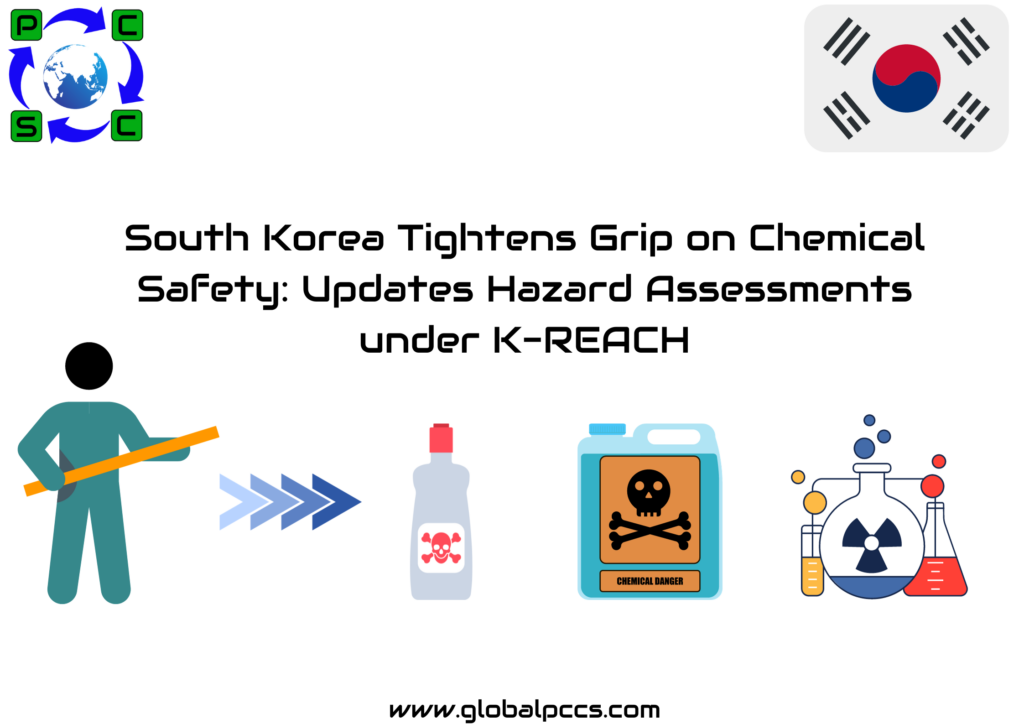 South Korea’s commitment to chemical safety and environmental protection takes a further step forward with the latest updates to hazard assessments under the Korean Registration and Evaluation of Chemical Substances (K-REACH) program. Announced on December 21, 2023, these updates highlight the ongoing efforts to identify and regulate potentially harmful chemicals.
South Korea’s commitment to chemical safety and environmental protection takes a further step forward with the latest updates to hazard assessments under the Korean Registration and Evaluation of Chemical Substances (K-REACH) program. Announced on December 21, 2023, these updates highlight the ongoing efforts to identify and regulate potentially harmful chemicals.
Key points of the recent K-REACH updates include:
Hazard assessments for 209 chemicals: The National Institute of Environmental Research (NIER) has reviewed and categorized the potential dangers of 124 new and 85 existing chemicals registered under K-REACH. Notably, 18 new and 68 existing chemicals were classified as toxic, raising concerns for their safe use and requiring stricter regulations.
Enhanced transparency: Details of the updated hazard assessments are made publicly available, allowing manufacturers, importers, and the general public to access crucial information about the potential risks associated with specific chemicals. This transparency fosters informed decision-making and responsible handling of hazardous substances.
Regulatory implications: The revised hazard classifications could trigger stricter control measures for the identified toxic chemicals. These may include restrictions on manufacture, import, use, and disposal, aimed at minimizing exposure and protecting public health and the environment.
The K-REACH updates demonstrate Korea’s proactive approach to chemical safety. By regularly evaluating and updating hazard assessments, the country ensures that potential risks are identified and addressed promptly. This proactive approach aligns with global trends towards stricter chemical regulations and responsible chemical management.
Potential impacts of the K-REACH updates:
Increased compliance costs: Manufacturers and importers of newly classified toxic chemicals may face higher costs associated with compliance with stricter regulations, such as obtaining permits, implementing safety measures, and adopting alternative chemicals.
Innovation in chemical development: The identification of hazardous chemicals could incentivize the development of safer alternatives, promoting advancements in green chemistry and sustainable production practices.
Enhanced public awareness: Public access to hazard assessment information can raise awareness about chemical safety and empower individuals to make informed choices about the products they use and the environments they live in.
Looking forward:
In Korea’s ongoing efforts to ensure chemical safety, the K-REACH upgrades represent a major milestone. It is still necessary to maintain constant watchfulness and conduct routine evaluations in order to recognise and manage new chemical hazards. Global efforts towards responsible chemical management and a safer future for everybody can be strengthened by cooperation with other nations and international organisations.
Summary
South Korea ramps up chemical safety: K-REACH updates identify harmful chemicals and promote transparency.
Review of 209 chemicals: New and existing substances assessed, with 18 new and 68 existing ones found toxic.
Enhanced transparency: Public access to hazard information for informed decision-making.
Stricter regulations: Potential restrictions on toxic chemicals to protect health and environment.
Impacts: Increased compliance costs, potential innovation in safer alternatives, and boosted public awareness.
Looking ahead: Continuous vigilance and global collaboration crucial for a safer future.
For more information on the impact please book a free consultation by filling the form or writing to us at manjunath.c@globalpccs.com








 Authorised IMDS & CDX Training & Consulting partner for
Authorised IMDS & CDX Training & Consulting partner for






